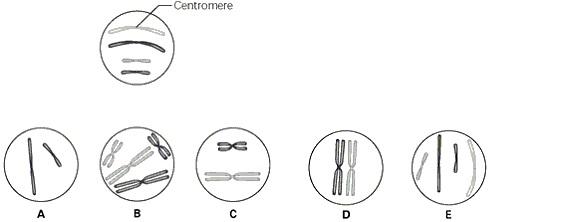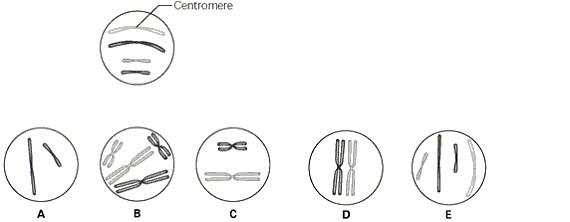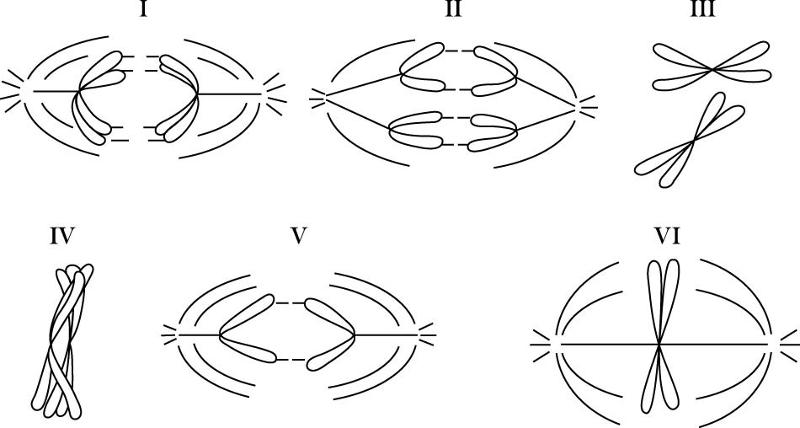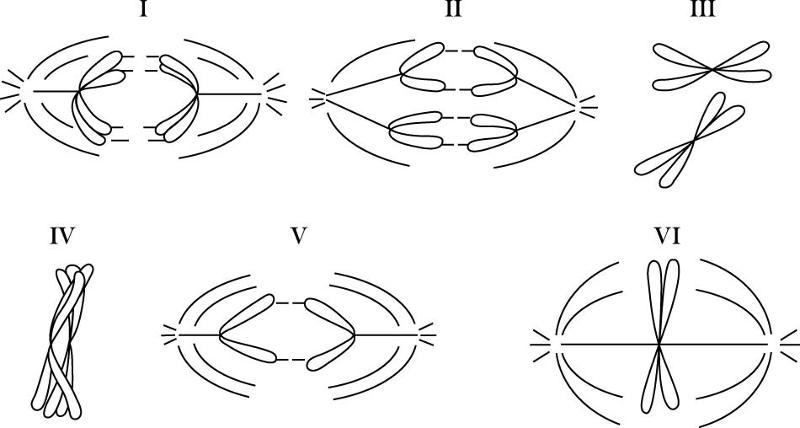Using the yeast signal transduction pathways, both types of mating cells release the mating factors.
These factors bind to specific receptors on the correct cells,
A) which induce changes in the cells that lead to cell fusion.
B) which produce more of the a factor in a positive feedback.
C) which in turn releases a growth factor that stimulates mitosis in both cells.
D) then one cell nucleus binds the mating factors and produces a new nucleus in the opposite
cell.
E) stimulating cell membrane disintegration, releasing the mating factors that lead to new yeast
cells.
A) which induce changes in the cells that lead to cell fusion.
Testosterone functions inside a cell by
A) binding with a receptor protein that enters the nucleus and activates specific genes.
B) becoming a second messenger that inhibits adenylyl cyclase.
C) acting as a signal receptor that activates tyrosine kinases.
D) acting as a steroid signal receptor that activates ion channel proteins.
E) coordinating a phosphorylation cascade that increases spermatogenesis.
A) binding with a receptor protein that enters the nucleus and activates specific genes.
Which of the following is true of transcription factors?
A) They control gene expression.
B) They initiate the epinephrine response in animal cells.
C) They regulate the synthesis of lipids in the cytoplasm.
D) They regulate the synthesis of DNA in response to a signal.
E) They transcribe ATP into cAMP.
A) They control gene expression.
One of the major categories of receptors in the plasma membrane reacts by forming dimers, adding
phosphate groups, and then activating relay proteins. Which type does this?
A) steroid receptors B) ligand-gated ion channels
C) receptor tyrosine kinases D) G protein-coupled receptors
C) receptor tyrosine kinases
If a pharmaceutical company wished to design a drug to maintain low blood sugar levels, one
approach might be to design a compound
A) to block G protein activity in liver cells.
B) that keeps sugar molecules from crossing the plasma membrane of liver cells.
C) that increases cAMP production in liver cells.
D) that activates epinephrine receptors.
E) that increases phosphorylase activity.
A) to block G protein activity in liver cells.
Which of the following is the best explanation for the fact that most transduction pathways have
multiple steps?
A) Each step can be activated by several G proteins simultaneously.
B) Most of the steps were already in place because they are steps in other pathways.
C) Multiple steps in a pathway require the least amount of ATP.
D) Multiple steps provide for greater possible amplification of a signal.
E) Each individual step can remove excess phosphate groups from the cytoplasm.
D) Multiple steps provide for greater possible amplification of a signal.
At puberty, an adolescent female body changes in both structure and function of several organ
systems, primarily under the influence of changing concentrations of estrogens and other steroid
hormones. How can one hormone, such as estrogen, mediate so many effects?
A) Estrogen binds to specific receptors inside many kinds of cells, each of which have different
responses to its binding.
B) The subcomponents of estrogen, when metabolized, can influence cell response.
C) Estrogen is produced in very large concentration and therefore diffuses widely.
D) Estrogen is kept away from the surface of any cells not able to bind it at the surface.
E) Estrogen has specific receptors inside several cell types, but each cell responds in the same
way to its binding.
A) Estrogen binds to specific receptors inside many kinds of cells, each of which have different
responses to its binding.
What are scaffolding proteins?
A) relay proteins that orient receptors and their ligands in appropriate directions to facilitate
their complexing
B) microtubular protein arrays that allow lipid-soluble hormones to get from the cell membrane
to the nuclear pores
C) large molecules to which several relay proteins attach to facilitate cascade effects
D) ladderlike proteins that allow receptor-ligand complexes to climb through cells from one
position to another
E) proteins that can reach into the nucleus of a cell to affect transcription
C) large molecules to which several relay proteins attach to facilitate cascade effects
Which of the following describes the events of apoptosis?
A) Its nucleus and organelles are lysed, then the cell enlarges and bursts.
B) The cell dies, it is lysed, its organelles are phagocytized, and its contents are recycled.
C) Its DNA and organelles become fragmented, it dies, and it is phagocytized.
D) Its DNA and organelles are fragmented, the cell shrinks and forms blebs, and the cell
self-digests.
E) The cell dies and the presence of its fragmented contents stimulates nearby cells to divide.
D) Its DNA and organelles are fragmented, the cell shrinks and forms blebs, and the cell
self-digests.
Why is apoptosis potentially threatening to the healthy "neighbors" of a dying cell?
A) Released cellular energy would interfere with the neighbors' energy budget.
B) Cell death would usually spread from one cell to the next via paracrine signals.
C) Bits of membrane from the dying cell could merge with neighbors and bring in foreign
receptors.
D) Neighboring cells would activate immunological responses.
E) Lysosomal enzymes exiting the dying cell would damage surrounding cells.
E) Lysosomal enzymes exiting the dying cell would damage surrounding cells.
Starting with a fertilized egg (zygote), a series of five cell divisions would produce an early embryo
with how many cells?
A) 4 B) 8 C) 32 D) 64 E) 16
C) 32
At which phase are centrioles beginning to move apart in animal cells?
A) telophase
B) anaphase
C) metaphase
D) prophase
E) prometaphase
D) prophase
Which of the following are primarily responsible for cytokinesis in plant cells but not in animal
cells?
A) actin and myosin
B) cyclin-dependent kinases
C) Golgi-derived vesicles
D) centrioles and centromeres
E) kinetochores
C) Golgi-derived vesicles
A group of cells is assayed for DNA content immediately following mitosis and is found to have an
average of 8 picograms of DNA per nucleus. How many picograms would be found at the end of S
and the end of G2?
A) 16; 16 B) 12; 16 C) 8; 16 D) 16; 8 E) 8; 8
A) 16; 16

The lettered circle in Figure 12.1 shows a diploid nucleus with four chromosomes. There are two pairs of homologous
chromosomes, one long and the other short. One haploid set is symbolized as black and the other haploid set is gray. The
chromosomes in the unlettered circle have not yet replicated. Choose the correct chromosomal conditions for the following
stages.
What is the correct chromosomal condition at the prometaphase of mitosis?
A) A B) B C) C D) D E) E
B) B

The lettered circle in Figure 12.1 shows a diploid nucleus with four chromosomes. There are two pairs of homologous
chromosomes, one long and the other short. One haploid set is symbolized as black and the other haploid set is gray. The
chromosomes in the unlettered circle have not yet replicated. Choose the correct chromosomal conditions for the following
stages.
What is the correct chromosomal condition for one daughter nucleus at telophase of mitosis?
A) A B) B C) C D) D E) E
E) E
Which of the following is true concerning cancer cells?
A) When they stop dividing, they do so at random points in the cell cycle; they are not subject to
cell cycle controls; and they do not exhibit density-dependent inhibition when growing in
culture.
B) They are not subject to cell cycle controls.
C) When they stop dividing, they do so at random points in the cell cycle, and they are not
subject to cell cycle controls.
D) They do not exhibit density-dependent inhibition when growing in culture.
E) When they stop dividing, they do so at random points in the cell cycle.
A) When they stop dividing, they do so at random points in the cell cycle; they are not subject to
cell cycle controls; and they do not exhibit density-dependent inhibition when growing in
culture.
For a chemotherapeutic drug to be useful for treating cancer cells, which of the following is most
desirable?
A) It does not alter metabolically active cells.
B) It is safe enough to limit all apoptosis.
C) It interferes with rapidly dividing cells.
D) It only attacks cells that are density dependent.
E) It interferes with cells entering G0.
C) It interferes with rapidly dividing cells.
Which of the following does not occur during mitosis?
A) replication of the DNA
B) condensation of the chromosomes
C) separation of sister chromatids
D) spindle formation
E) separation of the spindle poles
A) replication of the DNA
Which of the following is a true statement about sexual vs. asexual reproduction?
A) Asexual reproduction, but not sexual reproduction, is characteristic of plants and fungi.
B) Sexual reproduction requires that parents be diploid.
C) In asexual reproduction, offspring are produced by fertilization without meiosis.
D) In sexual reproduction, individuals transmit 50% of their genes to each of their offspring.
E) Asexual reproduction produces only haploid offspring.
D) In sexual reproduction, individuals transmit 50% of their genes to each of their offspring.
Which of the following defines a genome?
A) a karyotype
B) the complete set of an organism's polypeptides
C) the complete set of a species' polypeptides
D) representation of a complete set of a cell's polypeptides
E) the complete set of an organism's genes
E) the complete set of an organism's genes
Which of the following is true of a species that has a chromosome number of 2n = 16?
A) The species has 16 sets of chromosomes per cell.
B) A gamete from this species has four chromosomes.
C) The species is diploid with 32 chromosomes per cell.
D) Each cell has eight homologous pairs.
E) During the S phase of the cell cycle there will be 32 separate chromosomes.
D) Each cell has eight homologous pairs.
Which of these statements is false?
A) Single, haploid (n) sets of chromosomes in ovum and sperm unite during fertilization,
forming a diploid (2n), single-celled zygote.
B) Sexual life cycles differ with respect to the relative timing of meiosis and fertilization.
C) In humans, each of the 22 maternal autosomes has a homologous paternal chromosome.
D) In humans, the 23rd pair, the sex chromosomes, determines whether the person is female (XX)
or male (XY).
E) At sexual maturity, ovaries and testes produce diploid gametes by meiosis.
E) At sexual maturity, ovaries and testes produce diploid gametes by meiosis.
Which of the following best describes a karyotype?
A) a photograph of all the cells with missing or extra chromosomes
B) a pictorial representation of all the genes for a species
C) the collection of all the chromosomes in an individual organism
D) a display of each of the chromosomes of a single cell
E) the combination of all the maternal and paternal chromosomes of a species
D) a display of each of the chromosomes of a single cell
Chromatids are separated from each other.
A) The statement is true for meiosis I only.
B) The statement is true for mitosis and meiosis I.
C) The statement is true for mitosis and meiosis II.
D) The statement is true for meiosis II only.
E) The statement is true for mitosis only.
C) The statement is true for mitosis and meiosis II.

Refer to the drawings in Figure 13.2 of a single pair of homologous chromosomes as they might appear during various stages
of either mitosis or meiosis, and answer the following questions.
Which diagram represents anaphase I of meiosis?
A) I B) II C) IV D) V E) VI
A) I

Refer to the drawings in Figure 13.2 of a single pair of homologous chromosomes as they might appear during various stages
of either mitosis or meiosis, and answer the following questions.
Which diagram(s) represent anaphase II of meiosis?
A) II only
B) III only
C) IV only
D) V only
E) either II or V
D) V only
How is natural selection related to sexual reproduction as opposed to asexual reproduction?
A) Sexual reproduction results in many new gene combinations, some of which will lead to
differential reproduction.
B) Sexual reproduction allows the greatest number of offspring to be produced.
C) Sexual reproduction results in the most appropriate and healthiest balance of two sexes in the
population.
D) Sexual reproduction utilizes far less energy than asexual reproduction.
E) Sexual reproduction results in the greatest number of new mutations.
A) Sexual reproduction results in many new gene combinations, some of which will lead to
differential reproduction.
Homologous chromosomes move toward opposite poles of a dividing cell during
A) binary fission.
B) meiosis II.
C) fertilization.
D) mitosis.
E) meiosis I.
E) meiosis I.
Which life cycle stage is found in plants but not animals?
A) multicellular diploid
B) zygote
C) multicellular haploid
D) gamete
E) unicellular diploid
C) multicellular haploid
Why did the F1 offspring of Mendel's classic pea cross always look like one of the two parental
varieties?
A) Different genes interacted to produce the parental phenotype.
B) Each allele affected phenotypic expression.
C) The traits blended together during fertilization.
D) No genes interacted to produce the parental phenotype.
E) One phenotype was completely dominant over another.
E) One phenotype was completely dominant over another.
What was the most significant conclusion that Gregor Mendel drew from his experiments with pea
plants?
A) Recessive genes occur more frequently in the F1 generation than do dominant ones.
B) An organism that is homozygous for many recessive traits is at a disadvantage.
C) There is considerable genetic variation in garden peas.
D) Traits are inherited in discrete units, and are not the results of "blending."
E) Genes are composed of DNA.
D) Traits are inherited in discrete units, and are not the results of "blending."
Two plants are crossed, resulting in offspring with a 3:1 ratio for a particular trait. What does this
suggest?
A) that the parents were true-breeding for contrasting traits
B) that each offspring has the same alleles for each of two traits
C) that a blending of traits has occurred
D) that the parents were both heterozygous for a single trait
E) that the trait shows incomplete dominance
D) that the parents were both heterozygous for a single trait
Mendel accounted for the observation that traits which had disappeared in the F1 generation
reappeared in the F2 generation by proposing that
A) members of the F1 generation had only one allele for each trait, but members of the F2 had
two alleles for each trait.
B) traits can be dominant or recessive, and the recessive traits were obscured by the dominant
ones in the F1.
C) the traits were lost in the F1 due to dominance of the parental traits.
D) new mutations were frequently generated in the F2 progeny, "reinventing" traits that had
been lost in the F1.
E) the mechanism controlling the appearance of traits was different between the F1 and the F2
plants.
B) traits can be dominant or recessive, and the recessive traits were obscured by the dominant
ones in the F1.
In certain plants, tall is dominant to short. If a heterozygous plant is crossed with a homozygous
tall plant, what is the probability that the offspring will be short?
A) 1 B) 1/6 C) 1/2 D) 0 E) 1/4
D) 0
Which of the following calculations require that you utilize the addition rule?
A) Calculate the probability of a child having either sickle-cell anemia or cystic fibrosis if parents
are each heterozygous for both.
B) Calculate the probability of children with both cystic fibrosis and polydactyly when parents
are each heterozygous for both genes.
C) Calculate the probability of each of four children having cystic fibrosis if the parents are both
heterozygous.
D) Calculate the probability of black offspring from the cross AaBb × AaBb, when B is the symbol
for black.
E) Calculate the probability of purple flower color in a plot of 50 plants seeded from a
self-fertilizing heterozygous parent plant.
A) Calculate the probability of a child having either sickle-cell anemia or cystic fibrosis if parents
are each heterozygous for both.
Labrador retrievers are black, brown, or yellow. In a cross of a black female with a brown male, results can be either all black
puppies, 1/2 black to 1/2 brown puppies, or 3/4 black to 1/4 yellow puppies.
These results indicate which of the following?
A) Brown is dominant to black.
B) There is incomplete dominance.
C) Epistasis is involved.
D) Yellow is dominant to black.
E) Black is dominant to brown and to yellow.
C) Epistasis is involved.
Labrador retrievers are black, brown, or yellow. In a cross of a black female with a brown male, results can be either all black
puppies, 1/2 black to 1/2 brown puppies, or 3/4 black to 1/4 yellow puppies.
How many genes must be responsible for these coat colors in Labrador retrievers?
A) 2 B) 1 C) 4 D) 5 E) 3
A) 2
In one type cross of black × black, the results were as follows:
9/16 black
4/16 yellow
3/16 brown
The genotype aabb must result in which of the following?
A) yellow
B) black
C) white
D) brown
E) a lethal result
A) yellow
Which of the following describes the ability of a single gene to have multiple phenotypic effects?
A) multiple alleles B) epistasis
C) pleiotropy D) incomplete dominance
C) pleiotropy
Which of the following is an example of polygenic inheritance?
A) the ABO blood group in humans
B) white and purple flower color in peas
C) pink flowers in snapdragons
D) Huntington's disease in humans
E) skin pigmentation in humans
E) skin pigmentation in humans
Marfan syndrome in humans is caused by an abnormality of the connective tissue protein fibrillin.
Patients are usually very tall and thin, with long spindly fingers, curvature of the spine, sometimes
weakened arterial walls, and sometimes ocular problems, such as lens dislocation. Which of the
following would you conclude about Marfan syndrome from this information?
A) It has a late age of onset (> 60).
B) It is recessive.
C) It is pleiotropic.
D) It is epistatic.
E) It is dominant.
C) It is pleiotropic.
When Thomas Hunt Morgan crossed his red-eyed F1 generation flies to each other, the F2
generation included both red- and white-eyed flies. Remarkably, all the white-eyed flies were
male. What was the explanation for this result?
A) The gene involved is on the X chromosome.
B) Other female-specific factors influence eye color in flies.
C) The gene involved is on the Y chromosome.
D) Other male-specific factors influence eye color in flies.
E) The gene involved is on an autosome, but only in males.
A) The gene involved is on the X chromosome.
Sturtevant provided genetic evidence for the existence of four pairs of chromosomes in Drosophila
in which of these ways?
A) The overall number of genes in Drosophila is a multiple of four.
B) The entire Drosophila genome has approximately 400 map units.
C) Drosophila genes have, on average, four different alleles.
D) There are four major functional classes of genes in Drosophila.
E) Drosophila genes cluster into four distinct groups of linked genes.
E) Drosophila genes cluster into four distinct groups of linked genes.
Which of the following is the meaning of the chromosome theory of inheritance as expressed in the
early 20th century?
A) Homologous chromosomes give rise to some genes and crossover chromosomes to other
genes.
B) Natural selection acts on certain chromosome arrays rather than on genes.
C) Individuals inherit particular chromosomes attached to genes.
D) No more than a single pair of chromosomes can be found in a healthy normal cell.
E) Mendelian genes are at specific loci on the chromosome and in turn segregate during meiosis.
E) Mendelian genes are at specific loci on the chromosome and in turn segregate during meiosis.
Thomas Hunt Morgan's choice of Drosophila melanogaster has been proven to be useful even today.
Which of the following has/have continued to make it a most useful species?
I. its four pairs of chromosomes
II. a very large number of visible as well as biochemically mutant phenotypes
III. easy and inexpensive maintenance
IV. short generation time and large number of offspring
A) II and III only
B) II, III, and IV only
C) I and IV only
D) I, II, and III only
E) I, II, III, and IV
E) I, II, III, and IV
Males are more often affected by sex-linked traits than females because
A) male hormones such as testosterone often alter the effects of mutations on the X chromosome.
B) female hormones such as estrogen often compensate for the effects of mutations on the X
chromosome.
C) mutations on the Y chromosome often worsen the effects of X-linked mutations.
D) males are hemizygous for the X chromosome.
E) X chromosomes in males generally have more mutations than X chromosomes in females.
D) males are hemizygous for the X chromosome.
In cats, black fur color is caused by an X-linked allele; the other allele at this locus causes orange
color. The heterozygote is tortoiseshell. What kinds of offspring would you expect from the cross of
a black female and an orange male?
A) tortoiseshell females; black males
B) tortoiseshell females; tortoiseshell males
C) orange females; orange males
D) orange females; black males
E) black females; orange males
A) tortoiseshell females; black males
Which of the following statements is true of linkage?
A) Linked genes are found on different chromosomes.
B) Crossing over occurs during prophase II of meiosis.
C) The observed frequency of recombination of two genes that are far apart from each other has
a maximum value of 100%.
D) The closer two genes are on a chromosome, the lower the probability that a crossover will
occur between them.
E) All of the traits that Mendel studied–seed color, pod shape, flower color, and others–are due
to genes linked on the same chromosome.
D) The closer two genes are on a chromosome, the lower the probability that a crossover will
occur between them.

The following is a map of four genes on a chromosome.
Between which two genes would you expect the highest frequency of recombination?
A) A and G B) A and W C) A and E D) E and G E) W and E
A) A and G
One possible result of chromosomal breakage is for a fragment to join a nonhomologous
chromosome. What is this alteration called?
A) deletion
B) duplication
C) translocation
D) inversion
E) transversion
C) translocation